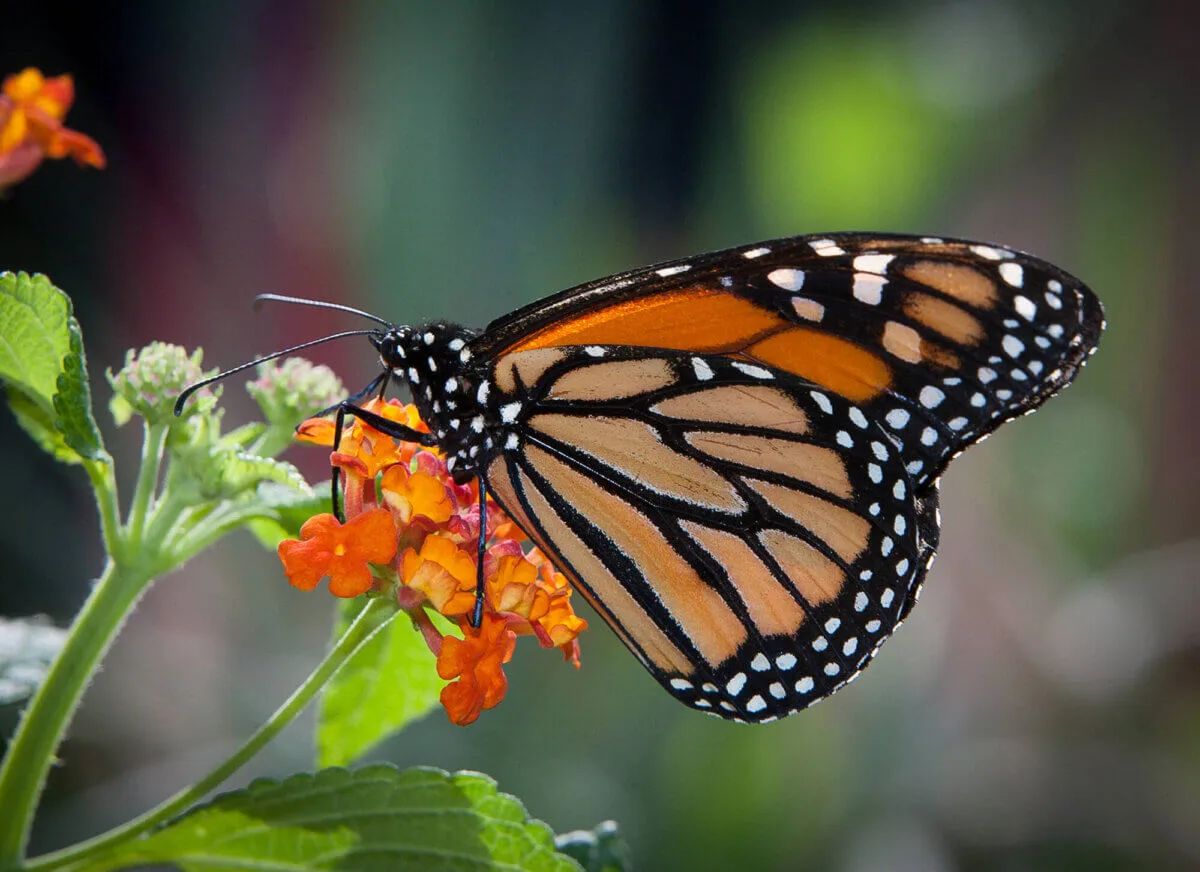
Despite a recent uptick in the population, the monarch butterfly is still endangered. The Desert Botanical Garden’s Majestic Mariposas exhibit runs March 4 through May 14. (Photo courtesy of Desert Botanical Garden)
The overall monarch population has decreased about 90% in two decades and is at risk of extinction.
Butterflies are back at the Desert Botanical Garden in Phoenix, which has been working for years to help boost the still-endangered monarch butterfly’s population, as well the milkweed plant it depends on for its lifecycle in the Grand Canyon State.
Majestic Mariposas, the garden’s spring butterfly exhibit, will welcome visitors daily through May 14 to see and learn about more than 2,000 native butterflies on display, including the iconic but dwindling monarch.
In the butterfly pavilion, guests can view caterpillars and chrysalises in the nursery where butterflies hatch and explore native milkweed that’s essential to the monarch’s survival.
“Their life cycle is amazing,” said Danielle Leyshon, the garden’s butterfly exhibit coordinator. “They go through these transformations from being the size of an eyelash to the size of a five-inch caterpillar and eating plants all day and then turning into a butterfly.”
RELATED: 7 Weird Arizona Destinations You Need to Visit
Despite some good news recently, the monarch population remains dangerously low. There was an uptick of about 35% in the monarch population wintering in Mexico during the 2021-2022 winter, according to Journey North.
While conservationists were pleased with that boost, the overall monarch population has decreased about 90% in two decades and is at risk of extinction.
The Switzerland-based International Union for Conservation of Nature said the monarch’s western population was once 10 million and declined to about 1,914 butterflies between the 1980s and 2021, putting it on the group’s Red List of Threatened Species.
Monarch have two populations—east and west of the Rockies. Their wintering grounds are in oyamel fir forests in Mexico’s Sierra Madre Mountains and among the eucalyptus, Monterey pines and Monterey cypresses in Southern California. Western monarchs typically overwinter along the California coast, but some join their eastern cousins in Mexico, according to the nonprofit Pollinator Partnership.
Arizona provides “a necessary opportunity for conservation, because we’re getting both of the different populations,” Leyshon said.
RELATED: LGBTQ Outdoor Adventure Group Provides Healthy, Sober Way to Meet People in Phoenix
Monarch counts are conducted in Mexico when they are overwintering. The round trip to Mexico takes about four generations for monarchs to complete, Leyshon said. In 2022, there were 350,000 monarchs counted in Mexico, up from less than 2,000 in 2020, and about 250,000 in 2021, Leyshon said.
Optimal weather, less competition for resources and a decrease in the use of pesticides during the pandemic are theories for the slight uptick, Leyshon said. But deforestation, land development and climate change continue to wreak havoc on the monarch population. Planting the right species of milkweed, which is also dwindling, is an important way to help the monarch.
Monarchs “can only eat their host plants (milkweed), and that’s why it’s important,” Leyshon said.
The garden’s ongoing Great Milkweed Grow Out—started in 2016 and overseen by the Pollinator Conservation Research Program—offers the right varieties of native milkweed for Arizonans to buy and plant in their own gardens. Even more of the plants will be available during the garden’s spring plant sale, March 17-19.
The milkweed family is the only genus on which monarchs lay their eggs. Monarch caterpillars also eat milkweed for the plant’s toxins, which makes them poisonous to predators, Leyshon said.
“Say a bird eats a monarch,” Leyshon explained. “The bird’s going to be having a bad stomach ache or other reactions, and then, in the future, they’re not going to want to eat an orange butterfly.”
Milkweed has been declining with the monarch since the 1950s, according to the journal “Proceedings of the National Academy of Sciences.” Toxicity is part of the reason milkweed is more scarce; some species of the plant have caused death in grazing livestock, according to Monarch Watch, a nonprofit educational outreach program at the University of Kansas.
“People, for many years, haven’t valued it as a plant they want in their spaces,” said Natalie Melkonoff, plant and insect ecology program manager at the Desert Botanical Garden.
Milkweed has declined mostly due to farmers and landowners who see it as a roadside weed and kill it. But some farmers have planted milkweed on the side of their crop fields to counter destroying milkweeds in their fields, Melkonoff said.
There are 73 species of native milkweed in the United States, and about 30 species are native to Arizona, Leyshon said. The garden’s research program has been trying to find the best native species. The garden grows four of the native species and sells the plants at its garden shop, Leyshon said.
Native species of milkweed are essential. Leyshon cautioned against Arizonans planting tropical milkweed, which confuses monarchs into thinking they are already in their tropical overwintering grounds and stops their migration. Parasites in tropical milkweed have also caused problems, according to the American Association for the Advancement of Science’s science.org.
Because chemical pesticides can harm butterflies, the garden is growing milkweed using only ladybugs as a natural pesticide, Leyshon said. The garden also uses harvester ants to enrich the soil.
Melkonoff said the Great Milkweed Grow Out does seem to be helping educate the public. Since the program started, more people seem interested in adding milkweed to their gardens, she said.
Leyshon said monarchs are “pollinators and food for prey and a beautiful, unique species.”
“Their migration is just tremendous,” Leyshon said. “The fact that a small, little insect, that usually only lives two to four weeks, makes an almost 4,000-mile round-trip journey and knows where to go.”
Looking for the latest Arizona news? Sign up for our FREE daily newsletter.
Politics

Biden announces new action to address gun sale loopholes
The Biden administration on Thursday announced new action to crack down on the sale of firearms without background checks and prevent the illegal...

Biden cancels student loan debt for 7,000 more Arizonans
The Biden administration on Friday announced its cancellation of an additional $7.4 billion in student debt for 277,000 borrowers, including 7,000...
Local News

Here are 8 of the best farmers markets in Arizona
The bright sun shining down on the tents covering the local wares as a light breeze caresses the cheeks of every passerby. The scent of plants in...

Step up to the plate and try these weird foods sold at Chase Field
How about those Diamondbacks? Since the D-backs went to the World Series last season, interest in the team hasn’t been this high in quite a while....




